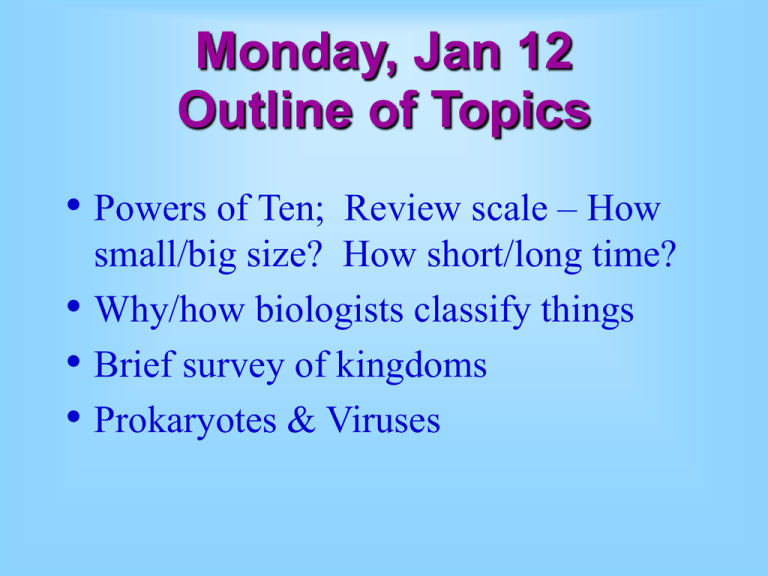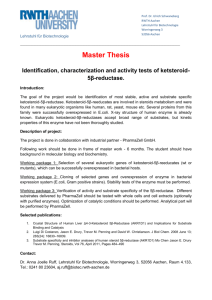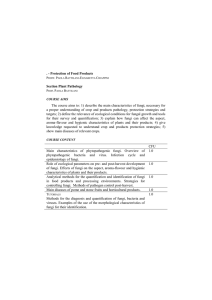Biodiversity
advertisement

Monday, Jan 12 Outline of Topics • Powers of Ten; • • • Review scale – How small/big size? How short/long time? Why/how biologists classify things Brief survey of kingdoms Prokaryotes & Viruses -10 evolution 15 --1 million years 10 --1000 years --sun's distance --1 billion years —li f e —eukaryot es —ani mal s —Cambri an expl osi on —fi sh ( vert ebrat es) —land pl ant s & f ungi ( bryophyt es, l i chens) —land art hropods ( mi l l i pedes) —pl ant vascul ar t i ssue —amphi bi ans —amni ot e egg / seed —PANGEA begi ns —bees —mammal s —fl owers —di nosaurs ext i nct —pri mat es —homi ni ds —Homo sapi ens neandert hal ensi s —Homo sapi ens sapi ens --1 billion meters --15 bil yr (age of universe) -5 --1/10 second 5 10 15 --known universe --milky way galaxy --1 light year ecosystems --10 seconds --solar system --1 minute organisms --earth cells }--1--biome million meters --1 hour organismal interactions --1 kilometer --1 decimeter --1 centimeter --1 millimeter 5 --largest organism --1 month -- highest mountain --1 year community succession --average eukaryotic cell --1 micrometer (µm)-- average bacterial cell; eukaryotic nucleus, mitochondrion --width of DNA helix --1 Angstrom (Å) --carbon atom electron shell --1 nanometer --1 picometer --proton --carbon atom nucleus -15 molecules Log10(Seconds) 3. 5 bi l 1. 5 650 mi l 550 500 430 420 375 350 300 280 225 200 150 65 50 4 0. 2 0. 05 25 Log10(Meters) --1 millisecond cellular interactions -5 --1 microsecond Intersection of Time molecular interactions and Space --1 nanosecond -10 --1 picosecond -15 --1 femtosecond Origin is one meter and one second Links • Cosmic View http://www.vendian.org/mncharity/cosmicview/ • A Walk Through Time • http://www.globalcommunity.org/wtt/index. shtml Chris Scotese’s Paleomap Project http://www.scotese.com/earth.htm Powers of Ten http://www.powersof10.com/# • • Bio 102 Home Page http://fire.biol.wwu.edu/102/ Terminology • Terminology is not the focus of this course • You need to learn some basic terms: those in • • lab exercises and lecture notes “Taxa”: remember the phyla, (classes), and representative genera I introduce in lecture Do not remember all the bold-faced terms in the text * (although it might be nice for you to know them when you read the text – See Starr & Taggart Glossary) • Watch the references to chemistry and cells * (review chapters on chemistry and cells) New species must be validly described How many species are there? Plantae 248 Fungi 47 Algae 27 Porifera 5 Coelenterata 9 Platyhelminthes 12 Nematoda 12 Protozoa 31 Prokaryotes 5 Mammalia Aves 94 Reptilia 6 Amphibia 4 Pisces 19 Echinodermata 6 Mollusca 50 Annelida 12 Thousands of described species per phylum Prokaryotes 5 Protozoa 31 Algae 27 Plantae 248 Fungi 47 Porifera 5 Coelenterata 9 Platyhelminthes 12 Nematoda 12 Mollusca 50 Annelida 12 Non-insect Arthropoda 123 Insecta 751 Echinodermata 6 Pisces 19 Amphibia 4 Reptilia 6 Aves 9 Mammalia 4 Total = 1,381 thousand Non-insect Arthropoda 123 Data from World Resources Institute Insecta 751 How does this relate to the biodiversity we see today? Six Kingdoms defined • • • The six “kingdoms” * * * * * * Bacteria – in Domain Bacteria Archaea – in Domain Archaea Protista Plants in Domain Eukarya Fungi Animals } Simple diagnostic characters won’t always classify every organism into its proper kingdom * Prokaryotic / eukaryotic * Cell arrangement * Metabolism of carbon (autotrophs or heterotrophs?) The number of kingdoms is debatable







